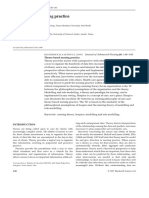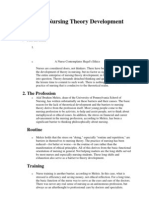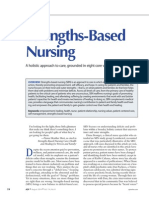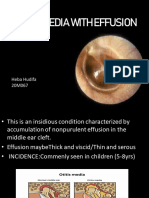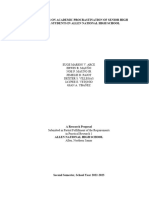0 ratings0% found this document useful (0 votes)
42 viewsWhy A Well-Paid Nurse Is A Better Nurse: Executive Summary
Why A Well-Paid Nurse Is A Better Nurse: Executive Summary
Uploaded by
Muhammad Fahrin AzhariThis article summarizes and rebuts an argument made by economist Anthony Heyes that paying nurses lower wages attracts better, more "vocationally called" nurses. The authors make several points:
1) Vocation does not guarantee skill - clinical and technical knowledge are also important for good nursing care.
2) Heyes makes assumptions about individual behavior and applies them to the entire nursing labor market, ignoring other factors.
3) Evidence shows higher wages improve nurse retention and morale, and are needed to attract skilled nurses who have family financial responsibilities.
4) In reality, low U.S. nursing wages contribute to the shortage of nurses and need to recruit foreign-trained nurses.
Copyright:
© All Rights Reserved
Available Formats
Download as PDF, TXT or read online from Scribd
Why A Well-Paid Nurse Is A Better Nurse: Executive Summary
Why A Well-Paid Nurse Is A Better Nurse: Executive Summary
Uploaded by
Muhammad Fahrin Azhari0 ratings0% found this document useful (0 votes)
42 views5 pagesThis article summarizes and rebuts an argument made by economist Anthony Heyes that paying nurses lower wages attracts better, more "vocationally called" nurses. The authors make several points:
1) Vocation does not guarantee skill - clinical and technical knowledge are also important for good nursing care.
2) Heyes makes assumptions about individual behavior and applies them to the entire nursing labor market, ignoring other factors.
3) Evidence shows higher wages improve nurse retention and morale, and are needed to attract skilled nurses who have family financial responsibilities.
4) In reality, low U.S. nursing wages contribute to the shortage of nurses and need to recruit foreign-trained nurses.
Original Title
Well Paid Nurse
Copyright
© © All Rights Reserved
Available Formats
PDF, TXT or read online from Scribd
Share this document
Did you find this document useful?
Is this content inappropriate?
This article summarizes and rebuts an argument made by economist Anthony Heyes that paying nurses lower wages attracts better, more "vocationally called" nurses. The authors make several points:
1) Vocation does not guarantee skill - clinical and technical knowledge are also important for good nursing care.
2) Heyes makes assumptions about individual behavior and applies them to the entire nursing labor market, ignoring other factors.
3) Evidence shows higher wages improve nurse retention and morale, and are needed to attract skilled nurses who have family financial responsibilities.
4) In reality, low U.S. nursing wages contribute to the shortage of nurses and need to recruit foreign-trained nurses.
Copyright:
© All Rights Reserved
Available Formats
Download as PDF, TXT or read online from Scribd
Download as pdf or txt
0 ratings0% found this document useful (0 votes)
42 views5 pagesWhy A Well-Paid Nurse Is A Better Nurse: Executive Summary
Why A Well-Paid Nurse Is A Better Nurse: Executive Summary
Uploaded by
Muhammad Fahrin AzhariThis article summarizes and rebuts an argument made by economist Anthony Heyes that paying nurses lower wages attracts better, more "vocationally called" nurses. The authors make several points:
1) Vocation does not guarantee skill - clinical and technical knowledge are also important for good nursing care.
2) Heyes makes assumptions about individual behavior and applies them to the entire nursing labor market, ignoring other factors.
3) Evidence shows higher wages improve nurse retention and morale, and are needed to attract skilled nurses who have family financial responsibilities.
4) In reality, low U.S. nursing wages contribute to the shortage of nurses and need to recruit foreign-trained nurses.
Copyright:
© All Rights Reserved
Available Formats
Download as PDF, TXT or read online from Scribd
Download as pdf or txt
You are on page 1of 5
Julie A.
Nelson
Nancy Folbre
Why a Well-Paid Nurse Is a
Better Nurse
I
N A RECENT ARTICLE TITLED “The es receive, along with their wage,
Executive Summary Economics of Vocation or from doing work that they “like”
䊳 Rebutting the argument by ‘Why Is a Badly Paid Nurse a or “feel a need to do.” The stan-
Heyes that lower wages attract Good Nurse?’” economist dard labor economics theory of
better, “vocationally called” Anthony Heyes (2005) argues that “compensating wage differentials”
nurses, the authors invalidate this a willingness to accept a lower posits that, all else equal, a person
position on several grounds in-
cluding existing research re- wage, all else equal, distinguishes will be willing to take a lower
garding the relationship between a “good” nurse from the “wrong wage for a job with characteristics
wages, retention, and patient sort.” Therefore, he argues, raising he or she prefers, than for a job
outcomes as well as forces evi- nurses’ pay would reduce the pro- with less-pleasing characteristics.
dent in the current nursing labor portion of nurses who have a voca- Drawing from this theory, Heyes
market. tion for it and result in a decrease asserts that someone with a “voca-
䊳 Simply put, the strength of in the quality of care. Lest such tion” for a service-oriented occu-
“vocation does guarantee skill” work be taken seriously — or tar- pation like nursing or teaching
and good nursing care hinges
heavily upon clinical and tech-
nish the reputation of all econo- will, all else equal, be willing to
nical knowledge. mists in the eyes of serious scholars enter that profession at a lower
䊳 In addition, Heyes projects the
of health care — this article, writ- wage than someone who does not
possible decisions of an indi- ten by two economists who have feel such a vocation.
vidual onto the entire labor studied the economics of occupa- So far, as an argument based
market, ignoring the possibili- tions with a “care” component on personal utility maximization
ty that some caring nurses (Folbre & Nelson, 2000), rebuts (and with the strong “all else
also need a well-paying job to Heyes’ argument. equal” clauses), the argument is
support their families. Heyes’ result is based on falla- relatively uncontroversial. The
䊳 Taking Heyes’ assertion to an cious reasoning and a disregard fallacious conclusions develop as
extreme, the best way to for considerable literature on qual- Heyes (a) fails to distinguish ade-
secure a fully “vocational”
workforce would be to rely ity of care, worker motivation, and quately between motivations and
solely on volunteers to deliver morale as will be discussed in this the quality of the job accom-
patient care. article. It also ignores actual nurs- plished, (b) uses a theory about
䊳 While Heyes asserts that high- ing shortages emerging in the individual behavior to make asser-
er wages “crowd out” good United Kingdom and many other tions about the characteristics of
nurses, he overlooks the evi- advanced industrial countries. the entire nursing labor market, (c)
dence that wages, when used There are many reasons to believe
as a form of recognition, can that higher salaries for nursing
“crowd in” good nurses.
would increase both the quantity
䊳 In reality, the lack of wage JULIE A. NELSON, PhD, is a Senior
and quality of nursing care. Research Associate, Global Development
incentives in the U.S. is one
factor leading to the labor and Environment Institute, Tufts
The “Bad Pay = Good Nursing” University, Medford, MA.
shortage and the need for
recruitment of foreign-trained Argument
NANCY FOLBRE, PhD, is a Professor of
nurses. Heyes models “vocation” as a Economics, University of Massachusetts,
“non-pecuniary benefit” that nurs- Amherst, MA.
NURSING ECONOMIC$/May-June 2006/Vol. 24/No. 3 127
neglects the impact of pay on A person drawn into nursing by husbands for financial support.
employee morale and retention, the emotional and relational tasks This pool of truly caring people
and (d) overlooks the empirical may not be effective in communi- who don’t need the money is
realities of current nursing short- cating a feeling of being “cared probably shrinking over time,
ages. for,” just as others who feel a however, given rising divorce
strong vocation to be poetic may rates and other changes in family
Motivations and Quality not ever successfully pen good structure. To the extent that nurs-
While vocation may be a nec- poetry. Heyes falls prey to a logi- ing education gets increasingly
essary condition for high-quality cal fallacy when he equates inten- technical and expensive, even
performance in many jobs, it is by tion with accomplishment. fewer people have the luxury of
no means a sufficient condition. making a decision to enter this
Vocation does not guarantee skill. Individual Analysis Is Not Market profession without worry about its
Someone who is effective in mak- Analysis financial implications.
ing patients feel truly “cared for” The theory of compensating People with real financial
provides higher quality care than wage differentials applies at the responsibilities for themselves
someone who performs his or her level of an individual, making the and their families, on the other
routines mechanically, all else choice of whether or not to supply hand, would find it difficult to
equal. The vast majority of nurses, his or her labor. The idea that gen- choose a low-wage nursing job, no
we believe, do provide such high- erally paying nurses low salaries matter how generous their hearts.
quality nursing or at least would is an argument that goes beyond Accepting such a job could mean
like to, if staffing levels and other the individual level to encompass putting the needs of their patients
employer policies would allow larger issues of market-level sup- before the needs of their own
them. But there are at least two ply. Regarding the available labor dependents. Caring, intelligent,
places for slippage between per- pool, Heyes assumes that the dis- organized, educated, and honest
sonal feelings of vocation and tribution of abilities and reserva- people with other options are not
quality of outcomes. tion wages among nurses with and only in demand for nursing, but in
First, nursing, has, unfortu- without vocation would be identi- demand for other occupations as
nately, long suffered from the cal, were it not for the vocation well. Higher wages elsewhere
stereotype that its practitioners factor. (The “reservation wage” is will, therefore, draw them out of
need only be motivated by love. the lowest wage that can be the low wage labor pool. This is
Some nurses complain that offered and still draw a worker not because they are “greedy,” but
patients, families, and fellow staff into a labor market.) Yet the rela- because in a modern economy one
treat them as unskilled, kindly tion between vocation and reser- needs income to pay for groceries
“angels” or “pillow-fluffers” rather vation wage should be a topic for and rent (The fallacious nature of
than skilled and caring profession- empirical study, not theoretical the equation of concern about
als. In judging quality of care, assertion. In fact, there is good money with “greed” is discussed
emotional competence is impor- reason to believe that nursing in Nelson, 1999). People with
tant, but should not be focused on applicants who have a full set of financial responsibilities (howev-
to the neglect of other medical, the emotional and other compe- er caring, competent, and voca-
technical, and organizational com- tencies that would enable them to tion-oriented they may be) must, if
petencies. The best nurses are those provide quality care will tend to they can, take jobs that pay wages
who combine both. Acquisition of have systematically higher reser- sufficient to support themselves
technical skills through nursing vation wages than lower-quality and their families.
education is, of course, generally applicants. So besides people who don’t
an expensive proposition in terms This comes from observing need the money, the other group of
of both time and money. Wage the two main sorts of workers who people in the low-wage pool will
rates that imply a low or negative may populate the low-wage pool. tend to be those who do need the
return on this initial investment First, As Heyes posited, some peo- money, but have no better alterna-
(especially if they create hardship ple are willing to accept low tives. These people may or may
in repaying educational loans) wages out of the goodness of their not be caring at all. In the case of
will discourage capable people hearts. These people must also, skilled nursing, these may be peo-
from entering this profession. presumably, have relatively low ple who can achieve the minimum
Second, people drawn to any financial responsibilities. Histor- skills to keep their job, but who
occupation by the opportunities it ically, nurses (along with pre- aren’t likely to move elsewhere
may offer for a particular kind of school teachers and other “caring” because they are on the lower end
self-expression may or may not professionals) were often young when it comes to such things as
actually be competent at even childless women, or married general intelligence, work habits,
those expressive aspects of the job. women who could rely on their and organizational skills. Or they
128 NURSING ECONOMIC$/May-June 2006/Vol. 24/No. 3
may enter the nursing profession 1998). But that article focused on they are perceived to be acknowl-
because of preferential visa treat- the supply of caring labor as a edging” (1998, p. 444, emphasis in
ment or the fact that a subsidized whole, emphasizing the impor- original). That is, if compensation
education program offered them a tance of changing gender norms is structured such that it shifts the
way into a skilled occupation. and the need for a new social con- perceived locus of control outside
These workers are willing to tract. It did not argue against pay- the worker, vocation can be damp-
accept a low wage for nursing ment of higher wages for care ser- ened or extinguished. But if the
because their opportunity costs (in vice work. If one took Heyes’ argu- remuneration is understood as an
terms of jobs foregone) are low. ment to the extreme, the only way acknowledgment and appreciation
While in the case of registered to get a fully vocational nursing of the worker’s own intrinsic moti-
nurses the “low wage pool” has a labor force would be to rely on vations, it can strengthen such
floor related to skill and educa- volunteers. By neglecting the fact motivations.
tion, the implications of low- that even highly vocationally ori- Such research suggests that
wage-pool issues are especially ented people need to support overly regimented work and pay-
dramatic in the case of lesser- themselves, he fallaciously leaps ment structures that treat nurses as
skilled health aides. Nursing from a individual-level analysis of “just a pair of hands” that have to
homes and home health care agen- the propensity to take a certain be manipulated into producing the
cies, for example, often are forced wage, all else equal, to unrealistic maximum number of shots and
to draw on the absolute lowest- and unfounded conclusions about completed paperwork can, indeed,
wage pool of workers to get mini- the population of the pool of lead to reduced feelings of voca-
mum-wage aides and orderlies. workers who are available for tion. But the problem is not with
People with very low education work at low wages. payment itself. If high pay is given
levels, recent immigrants, and in such a way that nurses feel
non-English speakers are often Crowding Can Be “In” as Well as respected and rewarded for their
hired into these low-status, heavy “Out” care and professionalism, feelings
lifting, and often unpleasant jobs. Heyes twice (2005) cites the of vocation can be reinforced and
On rare (but frightening) occa- work of Bruno Frey on the issue of expanded. Akerlof’s (1982) concept
sions, people may be attracted to “crowding out” of “intrinsic moti- of gift exchange between employ-
health care occupations, whether vations” (such as vocation) by ers and workers is relevant here:
well or ill-paid, primarily because remuneration (identified as an Nurses frequently make a gift of
they offer easier access to drugs or “extrinsic motivation”) (Frey as care to their patients, as well as
opportunities for abuse. cited in Rabin [1998], Frey providing them with the benefit of
In addition to the earlier argu- [1993]). The “crowding out” story their extensive technical training
ment about the significant skills was made most famous by and expertise. But if that gift is not
necessary for nursing, we can also Richard Titmuss’s (1971) study of recognized, and honored, they may
add an argument based on the blood supply. It has been shown begin to withdraw it.
labor pool. Because skilled, car- that, in some cases, paying people “Crowding in,” or comple-
ing, and able people need decent to do something they might other- mentarity between intrinsic and
wages, it is quite possible — wise do voluntarily can drive out extrinsic motivation, can also be
though empirical study would be their impulses to do the activity explained in terms of endogenous
needed to establish this definitive- for their own pleasure, other’s ben- preferences. Following standard
ly — that higher wages would efit, or other internally supplied neoclassical assumptions, Heyes
attract a higher proportion of truly reasons. While Heyes’ own argu- takes nurse’s preferences and
caring, quality, skilled workers. A ment does not hinge on the crowd- “vocation” as exogenously given.
reasonably high wage can make it ing-out wage-motivation link, this While he allows that poor working
possible for a caring (feeling) per- story gives, of course, further conditions may lead to low morale
son to choose to train for an occu- apparent reinforcement to Heyes and to vocationally oriented nurs-
pation that includes a significant idea that paying nurses well is bad es leaving their jobs, he does not
caring (activity) component. policy. allow for the fact that the level of
Certainly, higher wages would at The more complete story, respect or lack thereof that nurses
least give nursing educators and however, is that intrinsic motiva- find expressed in their paycheck
managers a broader pool to choose tions may be either “crowded out” may change their level of intrinsic
from; it is unreasonable to sup- or “crowded in” by remuneration. motivation. For instance, a hospi-
pose that quality of care is com- Frey actually found that external tal administrator who explained to
pletely unobservable by them. motivations like pay “crowd-out his nursing staff that, after reading
Heyes cites an article that one intrinsic motivation if they are per- Heyes’ article, he had decided to
of us co-authored in support of his ceived to be controlling and they pay them less, is likely to notice a
argument (Folbre & Weisskopf, crowd-in intrinsic motivation if reduction in both morale and
NURSING ECONOMIC$/May-June 2006/Vol. 24/No. 3 129
retention. Nothing undermines greater demands in environments “Why Is a Badly Paid Executive a
altruistic preferences more than in which they have little control Good Executive”? $
the fear that they will be taken over the quality of care (Aiken,
advantage of by self-interested Clarke, Sloane, Sochalski, & REFERENCES
Aiken, L.H., Clarke, S.P, Sloane, D.M.,
opportunists (Simpson, 2003). Silber, 2002). These managerial Sochalski, D.M., & Silber, J.H. (2002).
practices do not encourage a voca- Hospital nurse staffing and patient
Empirical Realities tion for caring. Indeed, it seems mortality, nurse burnout and job dis-
The empirical reality is that likely that they discourage young satisfaction. Journal of the American
Medical Association, 288(16), 1987-
current policies in both the United men and women from entering the 1993.
Kingdom and United States have nursing profession. Aiken, L.H., Buchan, J., Sochalski, J.,
failed to generate a sustainable Nichols, B., & Powell, M. (2004).
supply of nurses. In both coun- Conclusion Trends in international nurse migra-
tries, reluctance to pay higher Heyes (2005) emphasizes the tion. Health Affairs, 23(3), 69-77.
Akerlof, G. (1982). Labor contracts as par-
wages to nurses has contributed to non-contractable dimensions of tial gift exchange. Quarterly Journal of
increased reliance on recruitment quality performance in nursing. Economics, 97, 543-569.
of nurses from developing coun- But as a growing literature sug- Brush, B.L., Sochalski J. , Berger, A.M.
tries. Between 1999 and 2002, the gests, the quality of services can (2004). Imported care: recruiting for-
eign nurses to U.S. health care facili-
number of foreign-trained nurses be difficult to measure in many ties. Health Affairs, 23(3), 78-87.
based in the United Kingdom dou- occupations. Folbre, N., & Nelson, J.A. (2000). For love
bled. In 2002, reflecting a growing For example, consider the or money – Or both? Journal of
trend, more nurses joined the UK case of the pay of chief executive Economic Perspectives, 14(4), 123-
nursing register from overseas officers (CEOs) of corporations in 140.
Folbre N., & Weisskopf, T. (1998). Did
than from educational institutions the United States. In this case, father know best? Families, markets
within Britain (Aiken, Buchan, consideration of the principal- and the supply of caring labor. In A.
Sochalski, Nichols, & Powell, agent problems involved in the Ben-Ner & L. Putterman (Eds.),
2004). In the United States, most relationship between the share- Economics, values and organization
(pp. 171-205). Cambridge, UK: Cam-
immigrant nurses come from the holders and the CEOs led to pre- bridge University Press.
Philippines; in the United Kingdom, scriptions that raised the financial Frey, B.S. (1993). Shirking or work morale?
most are from countries of sub- compensation of many execu- The impact of regulating. European
Saharan Africa. Given prevailing tives. Yet efforts to establish an Economic Review, 37(8), 1523-1532.
international differences it seems empirical link between perfor- Frey, B.S. (1998). Institutions and morale:
The crowding-out effect. In A. Ben-
likely that foreign-trained nurses mance and pay have proved Ner & L. Putterman (Eds.), Economics,
have a lower reservation wage — remarkably unsuccessful (Lavelle, values and organization (pp. 437-
not a greater “vocation” for nurs- 2005). Furthermore, the many 460). Cambridge, UK: Cambridge
ing — than their domestic coun- major accounting scandals re- University Press.
Heyes, A. (2005). The economics of voca-
terparts. vealed in top corporations in tion or ‘why is a badly paid nurse a
The resulting brain drain recent years suggest that personal good nurse’? Journal of Health
imposes serious costs on develop- opportunism in the executive Economics, 24(3), 561-569.
ing countries that invest heavily in suite imposes huge costs on soci- Lavelle, L. (2005, April 18). A payday for
nurse education. Indeed, the ety as a whole. performance? Business Week, p. 78.
Nelson, J. (1999). Of markets and martyrs:
South African nursing council has High pay can attract oppor- Is it ok to pay well for care? Feminist
proposed an export tariff on nurs- tunists in any job, with perverse Economics, 5(3), 43-59.
es leaving to work abroad (Brush, implications for quality. Why Rabin, M. (1998). Psychology and econom-
Sochalski, & Berger, 2004). Global should the selection effects of ics. Journal of Economic Literature,
36(1), 11-46.
health care recruitment represents high wage levels be thought to be Simpson, B. (2003). Sex, fear, and greed: A
a profitable new arena for entre- more perverse in nursing — where social dilemma analysis of gender and
preneurs who find ready clients pay levels are generally moderate cooperation. Social Forces, 82(1), 35-
among publicly funded health — than in top level managerial 52.
care institutions under pressure to posts, where salaries far exceed Titmuss, R.M. (1971). The gift relationship:
From human blood to social policy.
cut costs. Meanwhile, many nurs- average rates of return to equiva- New York: Vintage Books.
es, regardless of where they were lent levels of human capital?
trained, are susceptible to ever- When will we see a piece entitled
130 NURSING ECONOMIC$/May-June 2006/Vol. 24/No. 3
You might also like
- Zahid CNG Business PlanDocument52 pagesZahid CNG Business Planshahzaibmahu86% (7)
- Report of Semi-Expendable Property IssuedDocument16 pagesReport of Semi-Expendable Property IssuedAlgie Reñon100% (1)
- Clinical Reasoning Learning To Think Like A Nurse - (Chapter 1 Clinical Reasoning What It Is and Why It Matters)Document12 pagesClinical Reasoning Learning To Think Like A Nurse - (Chapter 1 Clinical Reasoning What It Is and Why It Matters)Laxmi100% (2)
- Reigniting Employee Engagement: A Guide to Rediscovering Purpose and Meaning in HealthcareFrom EverandReigniting Employee Engagement: A Guide to Rediscovering Purpose and Meaning in HealthcareNo ratings yet
- Conflict in HospitalDocument17 pagesConflict in HospitalAli AlamNo ratings yet
- The Antidote to Suffering: How Compassionate Connected Care Can Improve Safety, Quality, and ExperienceFrom EverandThe Antidote to Suffering: How Compassionate Connected Care Can Improve Safety, Quality, and ExperienceNo ratings yet
- My Philosophy of Professional Nursing PracticeDocument3 pagesMy Philosophy of Professional Nursing Practiceapi-581399200No ratings yet
- EmpathyDocument32 pagesEmpathyah78 ab19No ratings yet
- Nurse RetentionDocument18 pagesNurse Retentionapi-272317330No ratings yet
- The Role of Advocacy and Professional NursingDocument12 pagesThe Role of Advocacy and Professional Nursingbgrubbs678No ratings yet
- Hooker - Understanding Empathy: Why Phenomenology and Hermeneutics Can Help Medical Education and PracticeDocument12 pagesHooker - Understanding Empathy: Why Phenomenology and Hermeneutics Can Help Medical Education and PracticeCamille TobilloNo ratings yet
- 260-Elder AbuseDocument6 pages260-Elder Abuseapi-283974740No ratings yet
- Philosophy of NursingDocument9 pagesPhilosophy of NursingandriyoethNo ratings yet
- Civility in NursingDocument7 pagesCivility in Nursingshawnee11No ratings yet
- Nursing Philosophy PaperDocument6 pagesNursing Philosophy PaperDanielle AalderinkNo ratings yet
- The Learning Experience of A Student Nurse, A Critical AnalysisDocument7 pagesThe Learning Experience of A Student Nurse, A Critical AnalysisMae Azores100% (2)
- Theory-Based Nursing Practice: Accepted For Publication 5 June 1996Document9 pagesTheory-Based Nursing Practice: Accepted For Publication 5 June 1996brallon urieNo ratings yet
- Nursing TheoryDocument56 pagesNursing TheoryMichelle Ayyah PerniaNo ratings yet
- Ethical Dilemmas in Nursing PDFDocument5 pagesEthical Dilemmas in Nursing PDFtitiNo ratings yet
- Nursing Philosophy Apa PaperDocument7 pagesNursing Philosophy Apa Paperapi-449016836No ratings yet
- Professional Nursing Practice IssueDocument8 pagesProfessional Nursing Practice Issueapi-675875543No ratings yet
- CASE 6.3 Case 6.3 Cultures at Work-The Case of Home Care ServiceDocument4 pagesCASE 6.3 Case 6.3 Cultures at Work-The Case of Home Care Servicenguyenvinhat2003No ratings yet
- ML Does Team Nursing Work? Two Views:: The Polite Term For Task AllocationDocument3 pagesML Does Team Nursing Work? Two Views:: The Polite Term For Task AllocationNsafifahNo ratings yet
- Neale Educator Interview Nur 631Document5 pagesNeale Educator Interview Nur 631api-726948535No ratings yet
- Recognition of PerceptorDocument7 pagesRecognition of PerceptorzakyNo ratings yet
- Nursing Dissertation CommunicationDocument7 pagesNursing Dissertation CommunicationCollegePapersToBuyCanada100% (2)
- Barriers To Nursing Theory Development - 02.09.11Document2 pagesBarriers To Nursing Theory Development - 02.09.11caloy1083% (6)
- HauserDocument7 pagesHauserapi-643168582No ratings yet
- Motivation and Personal CharacteristicDocument11 pagesMotivation and Personal CharacteristicclaudiaNo ratings yet
- Family Nursing Is More Than Family Centered CareDocument12 pagesFamily Nursing Is More Than Family Centered Carefebie pachecoNo ratings yet
- Concept Map - R.YarbroughDocument5 pagesConcept Map - R.Yarbroughancheta.kmbNo ratings yet
- Dr. Patricia BennerDocument3 pagesDr. Patricia BennerbrylleNo ratings yet
- Running Head: Compassion Fatigue in Nursing 1Document11 pagesRunning Head: Compassion Fatigue in Nursing 1api-489685873No ratings yet
- Professional Roles PaperDocument8 pagesProfessional Roles Paperapi-665163291No ratings yet
- Leadership & Management 2013 HandoutsDocument138 pagesLeadership & Management 2013 HandoutsHampson Malekano88% (8)
- Letters: Teaching Professionalism To Medical Students To The Editor: DR Swick and ColleaguesDocument7 pagesLetters: Teaching Professionalism To Medical Students To The Editor: DR Swick and Colleaguesnurmaita rahmiati putriNo ratings yet
- Letters: Teaching Professionalism To Medical Students To The Editor: DR Swick and ColleaguesDocument7 pagesLetters: Teaching Professionalism To Medical Students To The Editor: DR Swick and Colleaguesnurmaita rahmiati putriNo ratings yet
- Reid K Professional Paper Nurs211Document6 pagesReid K Professional Paper Nurs211api-272402391No ratings yet
- England, P. Folbre, N. (1999) The Cost of CaringDocument14 pagesEngland, P. Folbre, N. (1999) The Cost of CaringLorena GuerrieraNo ratings yet
- NursingDocument6 pagesNursingapi-429796203No ratings yet
- Caroline Schmid ConstellationsinHealthcareDocument6 pagesCaroline Schmid ConstellationsinHealthcareParrelAnnNo ratings yet
- Nur300 Final Paper 1Document6 pagesNur300 Final Paper 1api-570381186No ratings yet
- Eliminating HV From WorkplaceDocument4 pagesEliminating HV From WorkplacejenniferNo ratings yet
- Think Critically and AnswerDocument3 pagesThink Critically and AnswerSareno PJhēaNo ratings yet
- Miedema 1993Document11 pagesMiedema 1993mariana alvarezNo ratings yet
- Interprofessional Collaboration Stephany VillacresDocument11 pagesInterprofessional Collaboration Stephany Villacresapi-376429631No ratings yet
- Revisiting The Impact of Job Satisfactio20160815-4145-1h16a7-LibreDocument9 pagesRevisiting The Impact of Job Satisfactio20160815-4145-1h16a7-LibreGoran PerićNo ratings yet
- Social Justice: A Concept For Undergraduate Nursing Curricula?Document15 pagesSocial Justice: A Concept For Undergraduate Nursing Curricula?Jairus Joel A. SuminegNo ratings yet
- NCM 103: Journal Reading Assignment Book Title: Caring in Nursing Classics Journal Article: Concepts of Caring and Caring As A ConceptDocument2 pagesNCM 103: Journal Reading Assignment Book Title: Caring in Nursing Classics Journal Article: Concepts of Caring and Caring As A ConceptAegel TorralbaNo ratings yet
- A Conceptual Framefwork For Home NursingDocument8 pagesA Conceptual Framefwork For Home NursingNur Inayah IsmaniarNo ratings yet
- Burnout Research 2019 AbellabnosaDocument16 pagesBurnout Research 2019 AbellabnosaRex Decolongon Jr.100% (1)
- Theoretical Foundation in NursingDocument8 pagesTheoretical Foundation in NursingElaisa Mae Delos SantosNo ratings yet
- NursingDocument5 pagesNursingNovickaNo ratings yet
- Getting It Done: Experienced Healthcare Leaders Reveal Field-Tested Strategies for Clinical and Financial SuccessFrom EverandGetting It Done: Experienced Healthcare Leaders Reveal Field-Tested Strategies for Clinical and Financial SuccessRating: 5 out of 5 stars5/5 (1)
- Motivational TheoriesDocument28 pagesMotivational TheoriesSUJITHNo ratings yet
- Nursing Is A Caring ProfessionDocument4 pagesNursing Is A Caring ProfessionselerapriapunyaNo ratings yet
- Collaborative Helping Family Process Bill MadsenDocument14 pagesCollaborative Helping Family Process Bill MadsenMarie Claire TestaNo ratings yet
- Exploring How New Registered Nurses Construct Professional Identity in Hospital SettingsDocument8 pagesExploring How New Registered Nurses Construct Professional Identity in Hospital Settingsmalyn1218No ratings yet
- CE Strengths Based Nursing.24Document9 pagesCE Strengths Based Nursing.24THOHAROHNo ratings yet
- Hildegard Peplau TheoryDocument6 pagesHildegard Peplau Theorymainavitalis254No ratings yet
- Nursing Is A Caring Profession 1Document4 pagesNursing Is A Caring Profession 1selerapriapunya100% (1)
- PDF Post Stroke Scalp Acupuncture DLDocument64 pagesPDF Post Stroke Scalp Acupuncture DLyohan100% (3)
- WLP 21ST CENTURY WEEK 1 - 2nd - QuarterDocument3 pagesWLP 21ST CENTURY WEEK 1 - 2nd - QuarterMARIA CECILIA BAUTISTA100% (1)
- Higher Secondary Blue Print 2020 21Document36 pagesHigher Secondary Blue Print 2020 21Rahul ANo ratings yet
- Daftar Nama Pengawas Try Out AkbarDocument85 pagesDaftar Nama Pengawas Try Out AkbarSuhadi HadiNo ratings yet
- Thyroid Function Test (TFT)Document16 pagesThyroid Function Test (TFT)PAPUN KUMAR ROUT100% (1)
- Elias Hicks - WikipediaDocument14 pagesElias Hicks - Wikipediafoxmulder467No ratings yet
- Generic Structure of Descriptive Text AreDocument2 pagesGeneric Structure of Descriptive Text AreSyaiful IpunkNo ratings yet
- Acc AnalysisDocument3 pagesAcc AnalysisMd Sifat KhanNo ratings yet
- 21ST PPT 2 AutosavedDocument24 pages21ST PPT 2 Autosavedcherish mae oconNo ratings yet
- About Lord Gani SHDocument44 pagesAbout Lord Gani SHMegha GargNo ratings yet
- 2 Theories of Second Language AcquisitionDocument46 pages2 Theories of Second Language AcquisitionTatyana LadyNo ratings yet
- Otitis Media With EffusionDocument16 pagesOtitis Media With EffusioncadburydanielNo ratings yet
- 21 Century Skills: The Challenges Ahead: Andrew J. Rotherham and Daniel WillinghamDocument59 pages21 Century Skills: The Challenges Ahead: Andrew J. Rotherham and Daniel WillinghamJeffrey C. ManiquizNo ratings yet
- Depression Associated With Dementia With Lewy Bodies (DLB) and The Effect of SomatotherapyDocument6 pagesDepression Associated With Dementia With Lewy Bodies (DLB) and The Effect of SomatotherapyRaluca ElenaNo ratings yet
- Hidden Treasures of IslamDocument468 pagesHidden Treasures of IslamZaidil Firza100% (1)
- SMA Bahasa - Inggris - 2009 PDFDocument15 pagesSMA Bahasa - Inggris - 2009 PDFsoe_barn64No ratings yet
- Gerunds After PrepositionsDocument13 pagesGerunds After PrepositionsCenobioNo ratings yet
- FM16 Ch18 Tool KitDocument7 pagesFM16 Ch18 Tool KitAdamNo ratings yet
- Acbang vs. Luczon, Jr. (G.R. No. 164246)Document4 pagesAcbang vs. Luczon, Jr. (G.R. No. 164246)RonStephaneMaylonNo ratings yet
- HUMSS PRACTICAL RESEARCH PRDocument37 pagesHUMSS PRACTICAL RESEARCH PRyuanaaerith13No ratings yet
- Smartax mt880 Adsl Router Quick Start-EnglishDocument3 pagesSmartax mt880 Adsl Router Quick Start-Englishredoctober24100% (2)
- World Religions Chart: Religion and Symbol Place of Origin Founder/ Key Figures Sacred Text Beliefs/PracticesDocument2 pagesWorld Religions Chart: Religion and Symbol Place of Origin Founder/ Key Figures Sacred Text Beliefs/PracticesNikay de los SantosNo ratings yet
- REED 9 2nd WEEK MODULEDocument4 pagesREED 9 2nd WEEK MODULERyan TamelinNo ratings yet
- Maine de Biran, JournalDocument143 pagesMaine de Biran, JournalJoana Maria PinhoNo ratings yet
- Poonam SharmaDocument1 pagePoonam SharmaDhruv SharmaNo ratings yet
- PDF Institutes of The Christian Religion, 2 Vols John Calvin DownloadDocument47 pagesPDF Institutes of The Christian Religion, 2 Vols John Calvin Downloadmiscammola100% (4)
- Bon vs. PeopleDocument13 pagesBon vs. PeoplecharmssatellNo ratings yet
- Interference Between Foundations, With Special Reference To Surface Footings in SandDocument9 pagesInterference Between Foundations, With Special Reference To Surface Footings in Sandmahd100% (1)

















